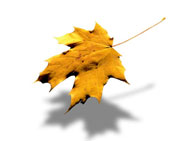|
The organ: technology and philosophy
Roughly
speaking, the organ of the Church of Santa Cruz de
Pedreguer is made up of the following components:
|
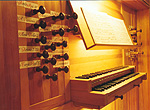 |
|
Teclats
Foto: Serafín Sivera |
24 registers
or stops, corresponding to two manual keyboards and one
pedal keyboard. The transmission of the notes to be
played is based on a suspended mechanism, which connects
the keys directly to the valves, a technique which was
already widely used for great organs in past centuries
because it allowed a sensitive and reliable touch of the
keys. The operation of the registers or the various tone
colours is likewise mechanical.
|
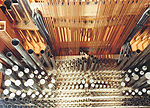 |
|
Tracció mecànica de l'orgue
Foto: Serafín Sivera |
The organ is
a wind instrument incorporating a motorized fan that
generates a wind current, and two leather bellows that
regulate the air flow and work like a pair of lungs.
The total
number of pipes amounts to 1500. They are made of wood
and tin, the form and dimensions of each of them having
been precisely calculated to match the acoustics at the
church in Pedreguer before they were made. The total
weight of the instruments is 9 metric tons, and it took
around 6000 hours to build the instrument. Behind these
technical details there is the desire of a whole team of
experts to create beauty and harmony in the shape of a
work of art which in itself embodies its own philosophy.
|
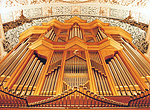 |
|
Perspectiva de l'orgue
Foto: Serafín Sivera |
The creation
of an organ is something unique and unrepeatable, and as
it is intended that the instrument should last for
centuries to come, we have taken on an additional
responsibility, still increased by the fact that the
instrument is a direct donation made by the Foundation
Server y Pérez, an institution that bought the
instrument and gave it to the town of Pedreguer.
A work of
art should always be something complete and balanced. An
organ consists of numerous different parts which have to
be very carefully crafted so that they interact and can
be operated in harmony and unison. This applies to the
design of the façade, the subtle and reliable movement
of each of its component mechanical parts, the physics
of air currents and the timbre of each organ pipe.
|
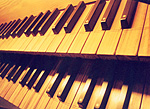 |
|
Perspectiva dels teclats
Foto: Serafín Sivera |
As far as
style is concerned, the organ of the church of Pedreguer
incorporates central European as well as Iberian
techniques, the musical result being that this symbiosis
allows the organist to play a wide range of works, but
above all, our instruments should be understood as a
contemporary expression that relates to the people
living on this transparent and sun-drenched
Mediterranean coast.
For
centuries organs used to be an indicator of culture and
prestige. With this instrument, with its energy and its
magnificent sound we would like to express the desire of
a large group of people to recover this culture and
prestige.
Gerhard
Grenzing
Master Organ-builder
|

